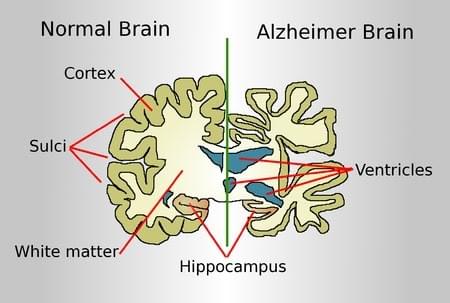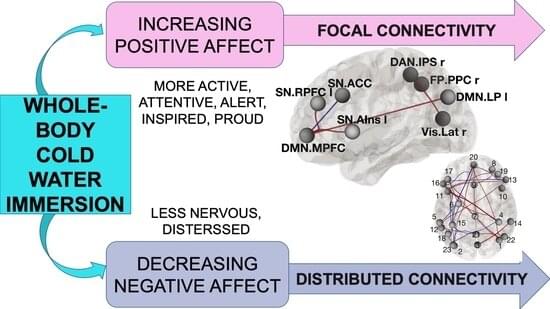We who must die demand a miracle.
𝐅𝐨𝐫 𝐭𝐡𝐞 𝐟𝐢𝐫𝐬𝐭 𝐭𝐢𝐦𝐞, 𝐚 𝐭𝐞𝐚𝐦 𝐨𝐟 𝐫𝐞𝐬𝐞𝐚𝐫𝐜𝐡𝐞𝐫𝐬 𝐡𝐚𝐬 𝐨𝐛𝐬𝐞𝐫𝐯𝐞𝐝 𝐜𝐡𝐚𝐧𝐠𝐞𝐬 𝐢𝐧 𝐡𝐨𝐰 𝐝𝐢𝐟𝐟𝐞𝐫𝐞𝐧𝐭 𝐩𝐚𝐫𝐭𝐬 𝐨𝐟 𝐭𝐡𝐞 𝐛𝐫𝐚𝐢𝐧 𝐢𝐧𝐭𝐞𝐫𝐚𝐜𝐭 𝐰𝐢𝐭𝐡 𝐞𝐚𝐜𝐡 𝐨𝐭𝐡𝐞𝐫 𝐚𝐟𝐭𝐞𝐫 𝐚 𝐩𝐞𝐫𝐬𝐨𝐧’𝐬 𝐛𝐨𝐝𝐲 𝐢𝐬 𝐢𝐦𝐦𝐞𝐫𝐬𝐞𝐝 𝐢𝐧 𝐜𝐨𝐥𝐝 𝐰𝐚𝐭𝐞𝐫. 𝐓𝐡𝐞 𝐟𝐢𝐧𝐝𝐢𝐧𝐠𝐬 𝐞𝐱𝐩𝐥𝐚𝐢𝐧 𝐰𝐡𝐲 𝐩𝐞𝐨𝐩𝐥𝐞 𝐨𝐟𝐭𝐞𝐧 𝐟𝐞𝐞𝐥 𝐦𝐨𝐫𝐞 𝐮𝐩𝐛𝐞𝐚𝐭 𝐚𝐧𝐝 𝐚𝐥𝐞𝐫𝐭 𝐚𝐟𝐭𝐞𝐫 𝐬𝐰𝐢𝐦𝐦𝐢𝐧𝐠 𝐨𝐮𝐭𝐬𝐢𝐝𝐞 𝐨𝐫 𝐭𝐚𝐤𝐢𝐧𝐠 𝐜𝐨𝐥𝐝 𝐛𝐚𝐭𝐡𝐬.
During a research trial, the results of which are published in the journal Biology, healthy volunteers were given a functional MRI (fMRI) scan immediately after bathing in cold water. These scans revealed changes in the connectivity between the parts of the brain that process emotions.
For the first time, a team of researchers has observed changes in how different parts of the brain interact with each other after a person’s body is immersed in cold water. The findings explain why people often feel more upbeat and alert after swimming outside or taking cold baths.
The research team from the University of Portsmouth, Bournemouth University and University Hospitals Dorset (UHD) recruited 33 volunteers for the trial.
Portable sensors and artificial intelligence are helping researchers decode animal communication—and begin to talk back to nonhumans.
In recent years, organic chemicals containing boron (B) and silicon (Si) have found applications in various fields, including optoelectronics and pharmaceuticals. Moreover, they can also serve as building blocks for complex organic chemicals. As a result, scientists are actively looking for new ways to leverage these versatile chemical tools as well as produce more kinds of organosilicon and organoboron compounds.
One limitation of the synthesis methods currently available for these chemicals is that we cannot introduce multiple B-and Si-containing groups in aromatic nitrogen heterocycles, i.e., carbon rings in which one of the carbon atoms is replaced by a nitrogen atom. If we could produce and freely transform such molecules, it would unlock the synthesis of several compounds relevant in medicinal chemistry.
Fortunately, a research team including Assistant Professor Yuki Nagashima from Tokyo Institute of Technology (Tokyo Tech), Japan has found a straightforward way around this limitation. As explained in their most recent study published in Nature Communications, the team has developed a method that allows them to modify quinolines, small organic molecules with an aromatic nitrogen heterocycle, with B-, Si-, and carbon-containing groups simultaneously.
The study shows that our brains exist between chaos and stability—a finding that could be used to help tweak them either way.
Northwestern University researchers have made a significant breakthrough in the field of seismology, developing a new earthquake probability model that will help scientists better predict when the next big earthquake will occur on a fault. The model, which was recently published in the Bulletin of the Seismological Society of America, offers a more comprehensive and realistic approach than current models.
Seismologists have long assumed that big earthquakes on faults are relatively regular and that the next quake will occur after a similar amount of time as between the previous two. However, the earth doesn’t always follow this pattern, and earthquakes can sometimes come sooner or later than expected. This is where the new model comes in, as it considers the specific order and timing of previous earthquakes to forecast the next one.
The model also helps explain why earthquakes sometimes come in clusters – groups with relatively short times between them, separated by longer times without earthquakes. The research team, consisting of seismologists and statisticians, was led by Stein, a faculty associate of Northwestern’s Institute for Policy Research (IPR) and co-authored by Professor Bruce D. Spencer and recent Ph.D. graduates James S. Neely and Leah Salditch.
An excellent overview of the story of how the U.S. responded to the COVID-19 pandemic along with suggestions for ways to continue making strides in combatting SARS-CoV-2 as well as how we may prepare for future emerging pathogens. The article provides an interesting case study on mechanisms of large-scale human organization, examines ways that we have succeeded in managing so many moving pieces, and explores ways that we could do better in the future. #nih #health #medicine #government #biotechnology
Investment, collaboration, and coordination have been key.
Francis Collins [email protected], Stacey Adam, […], Christine Colvis, Elizabeth Desrosiers, […], Ruxandra Draghia-Akli, Anthony Fauci, Maria Freire, Gary Gibbons, Matthew Hall, […], Eric Hughes, Kathrin Jansen, Michael Kurilla, H. Clifford Lane, Douglas Lowy, Peter Marks, Joseph Menetski, William Pao, Eliseo Pérez-Stable, Lisa Purcell, Sarah Read, Joni Rutter, Michael Santos, Tara Schwetz, Jeffrey Shuren, Timothy Stenzel, Paul Stoffels, Lawrence Tabak, Karen Tountas, Bruce Tromberg, David Wholley, Janet Woodcock, and John Young +29 authors +27 authors +22 authors fewer Authors Info & Affiliations
Science.
Chinese geneticist He Jiankui rocked the scientific world with his gene-edited baby experiments back in 2018, a highly controversial use of the technology that ended up sending him to a three-year stint in prison for illegal medical practices.
Now, just under a year after being released, He has some regrets about rushing into the experiments.
“I did it too quickly,” He told the South China Morning Post in a new interview.
I guess they’re John Wick fans.
The molecules kill some types of fungi “so efficiently that we named them after Keanu Reeves,” said the lead author of the study.
New work shows that histones, long treated as boring spools for DNA, sit at the center of the origin story of eukaryotes and continue to play important roles in evolution and disease.








